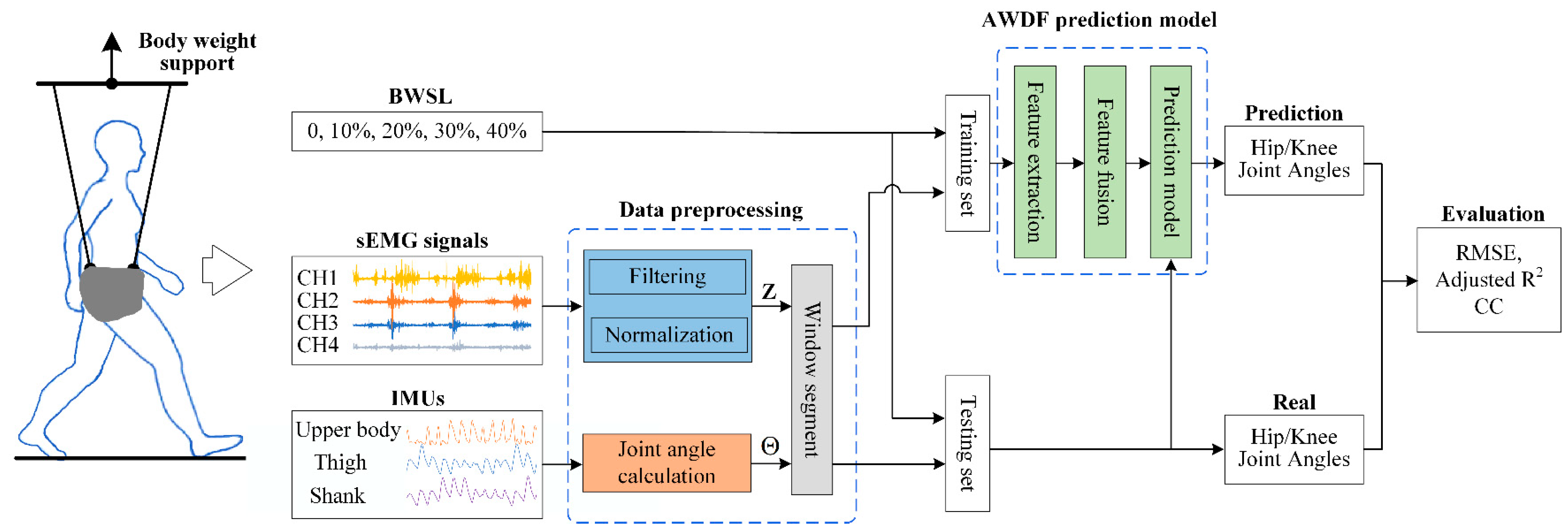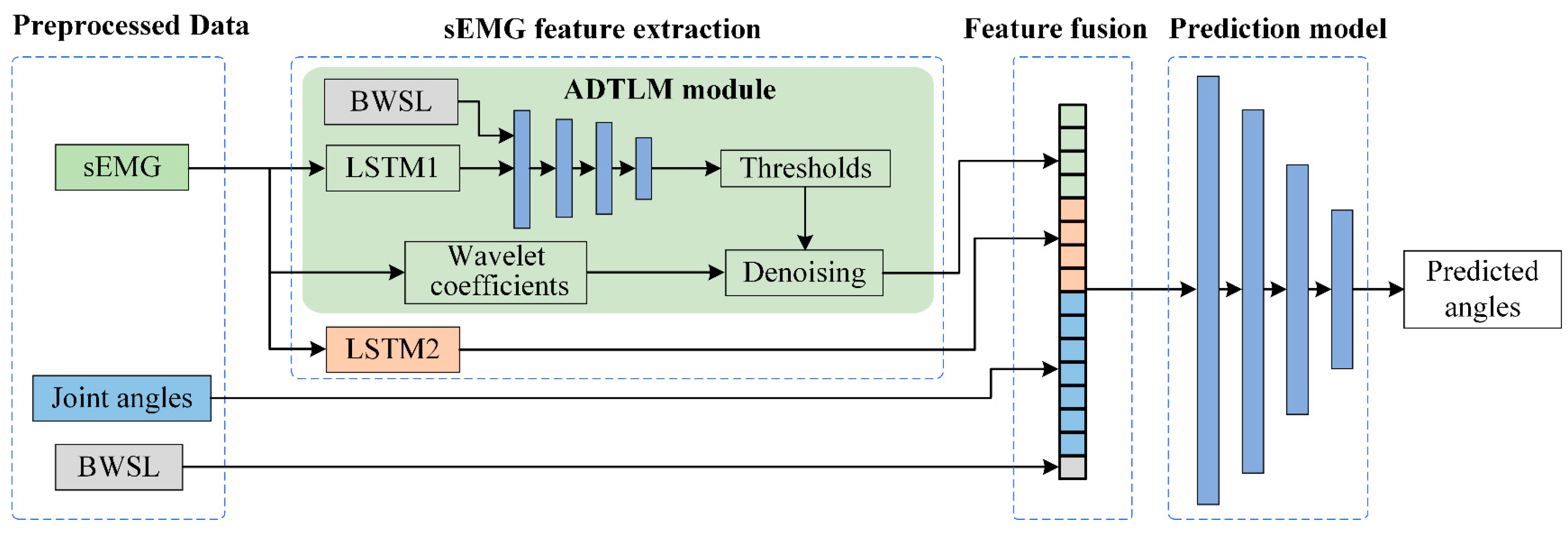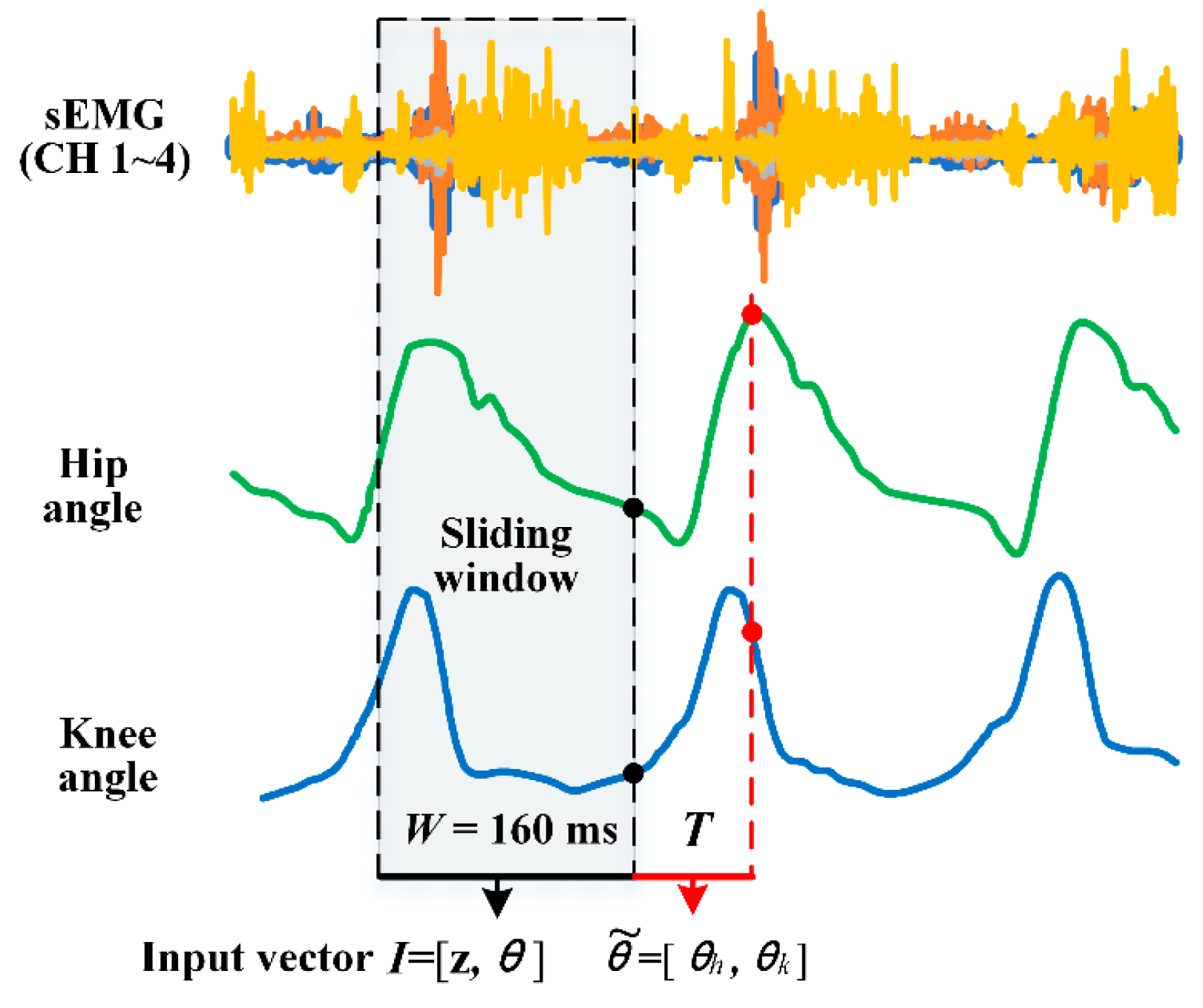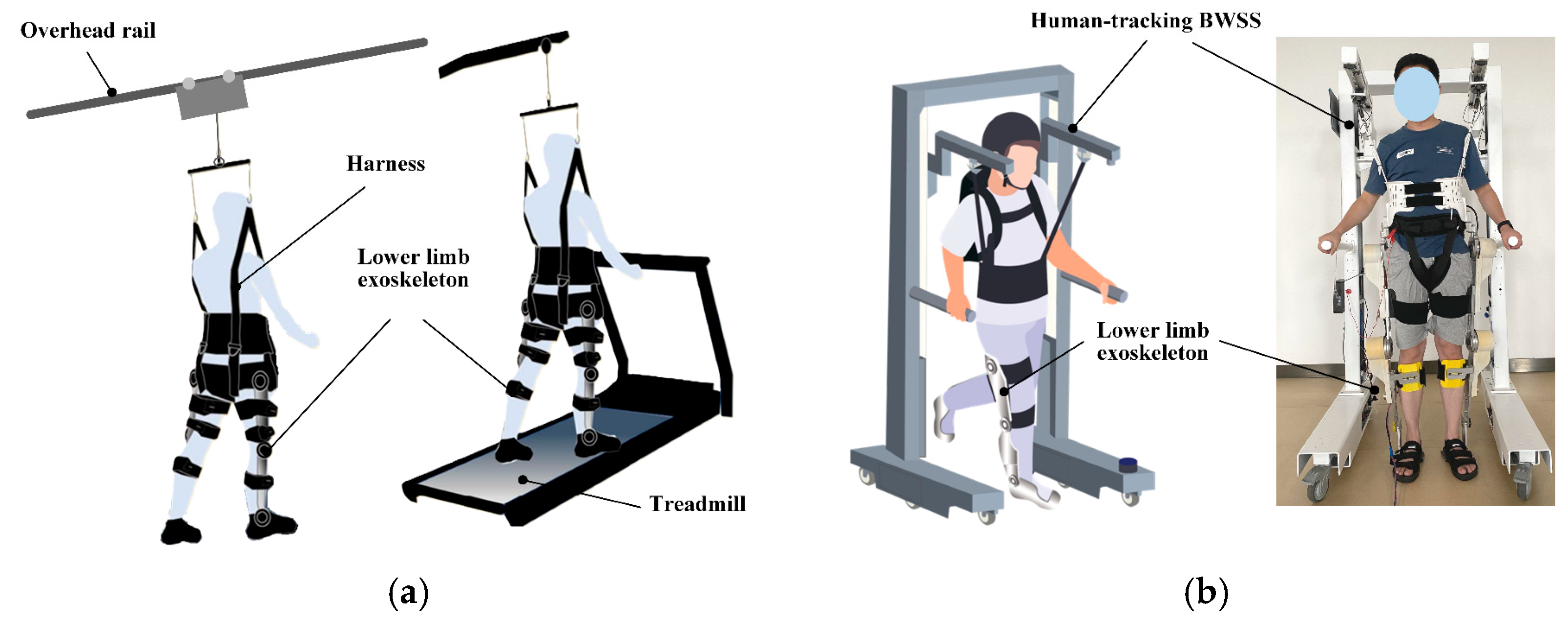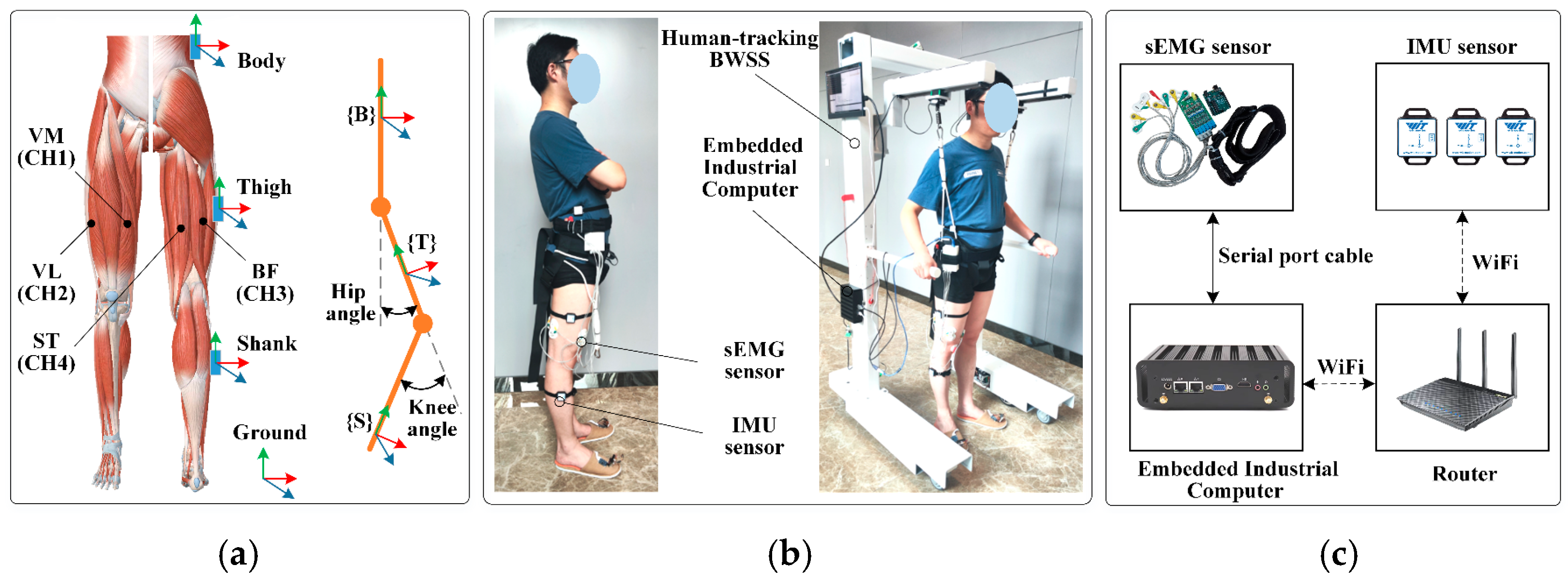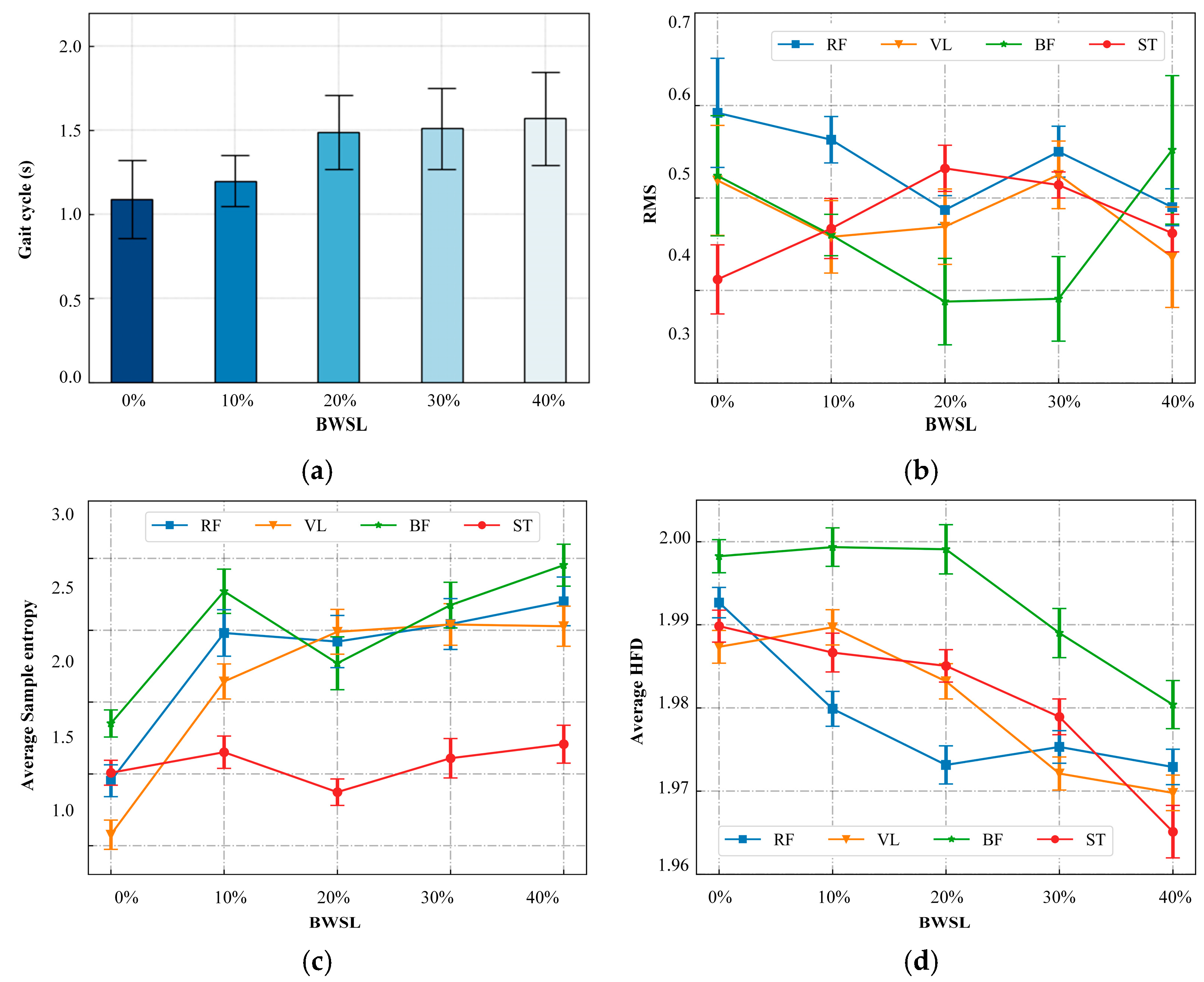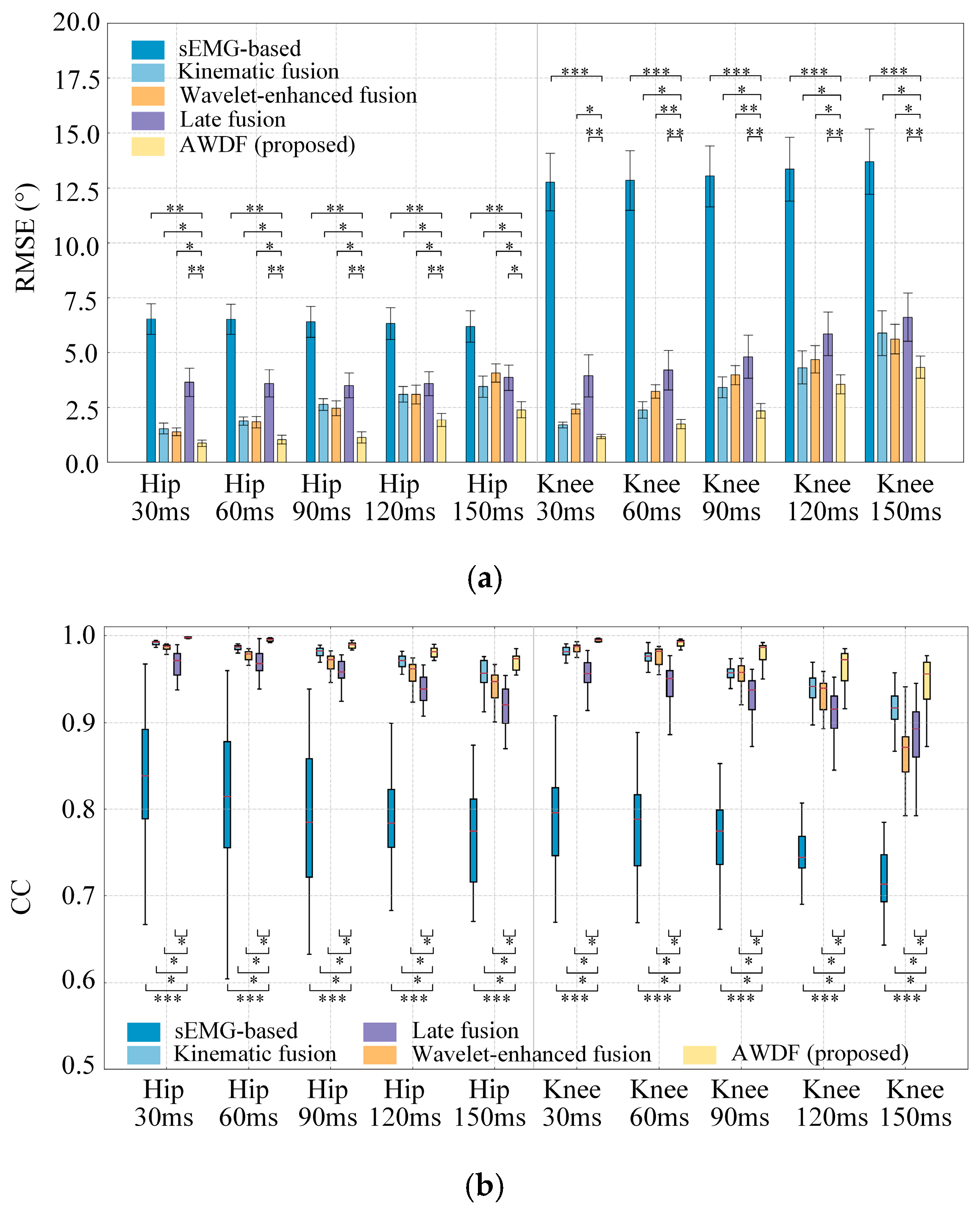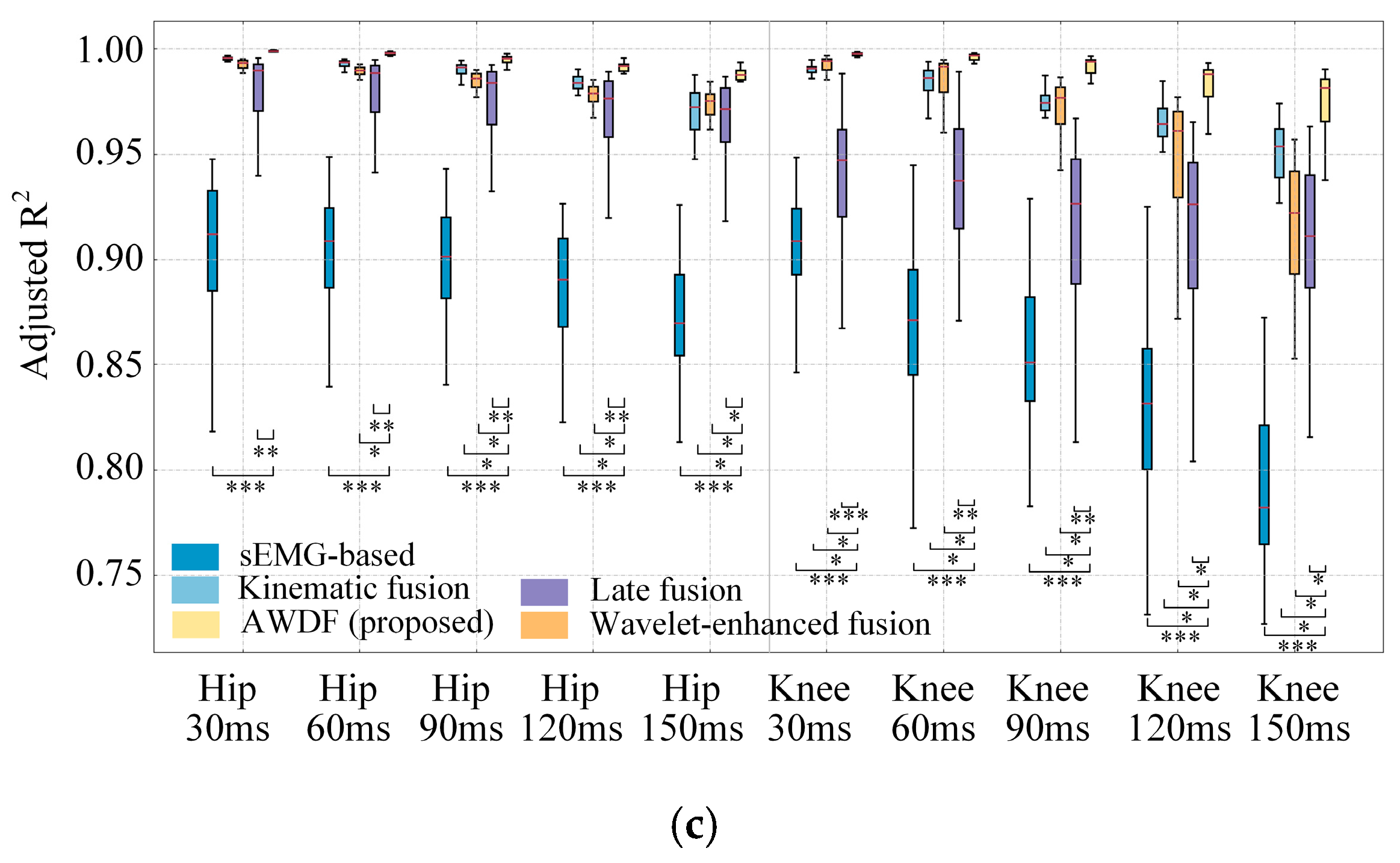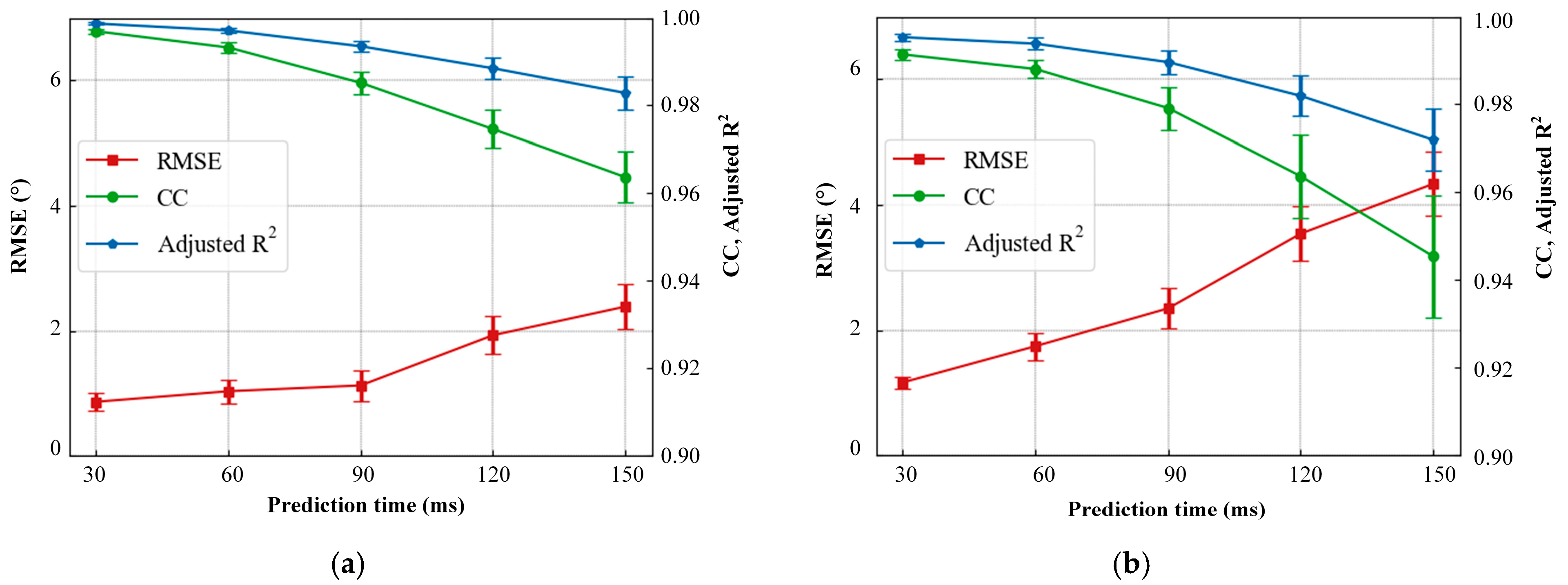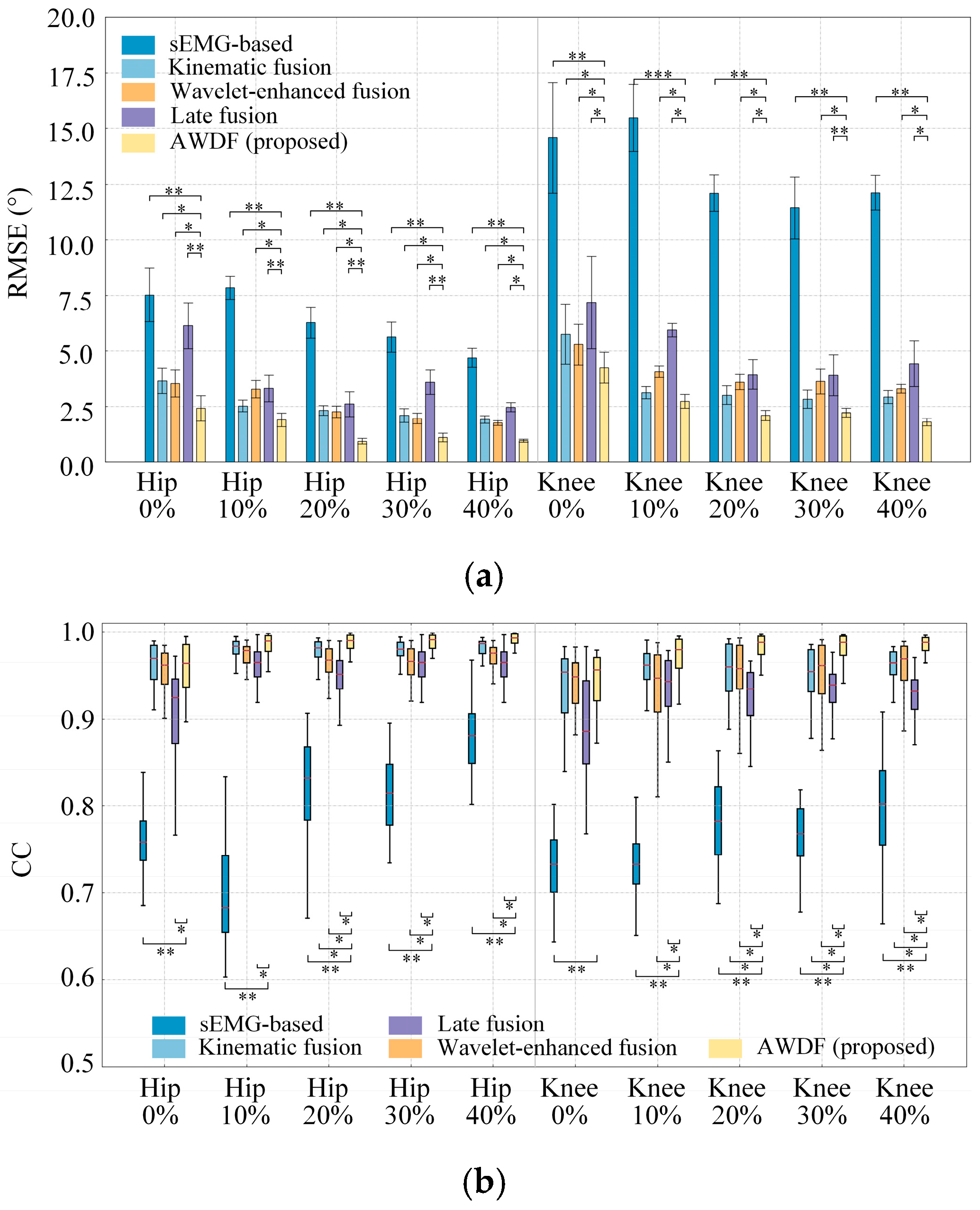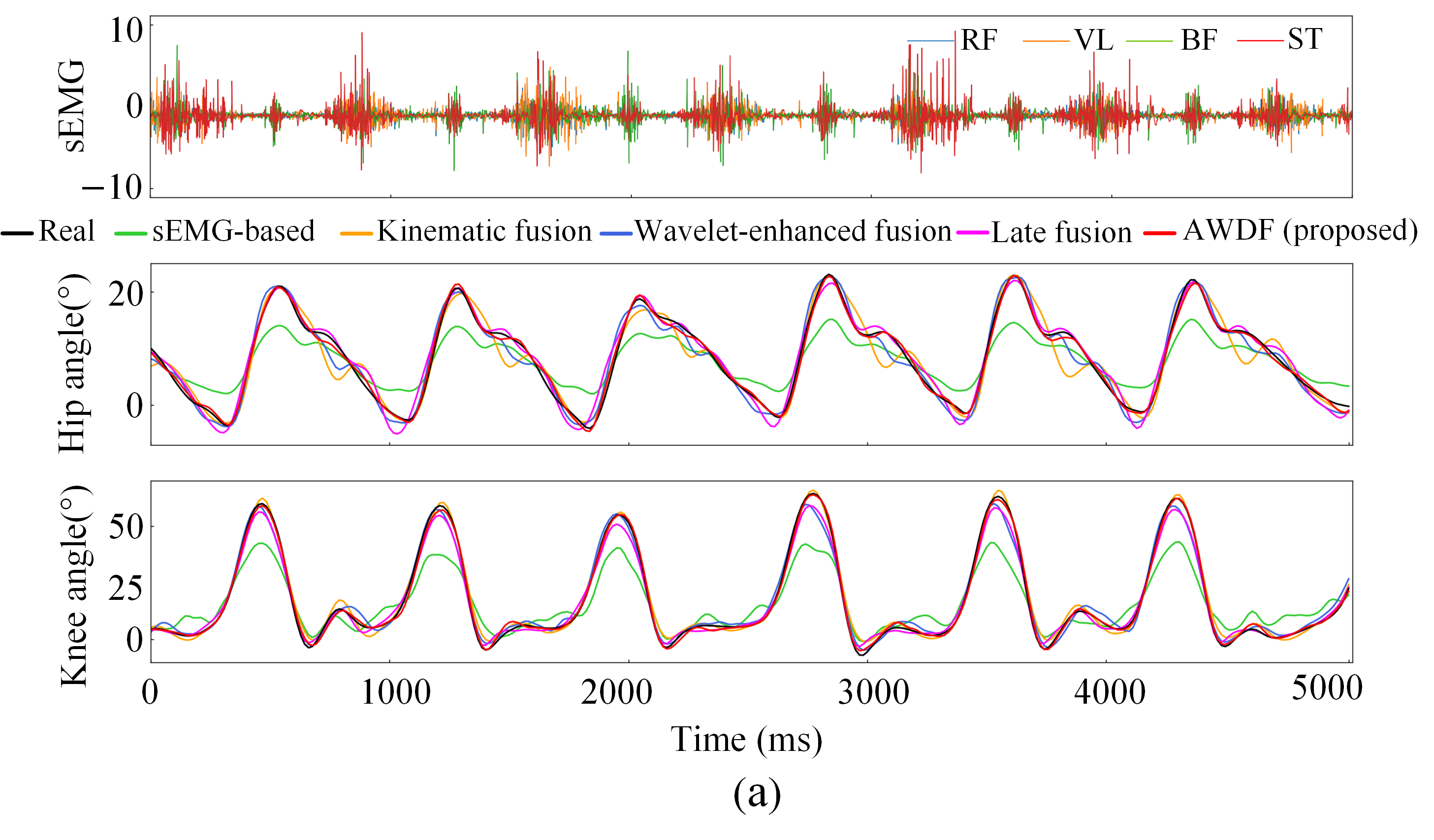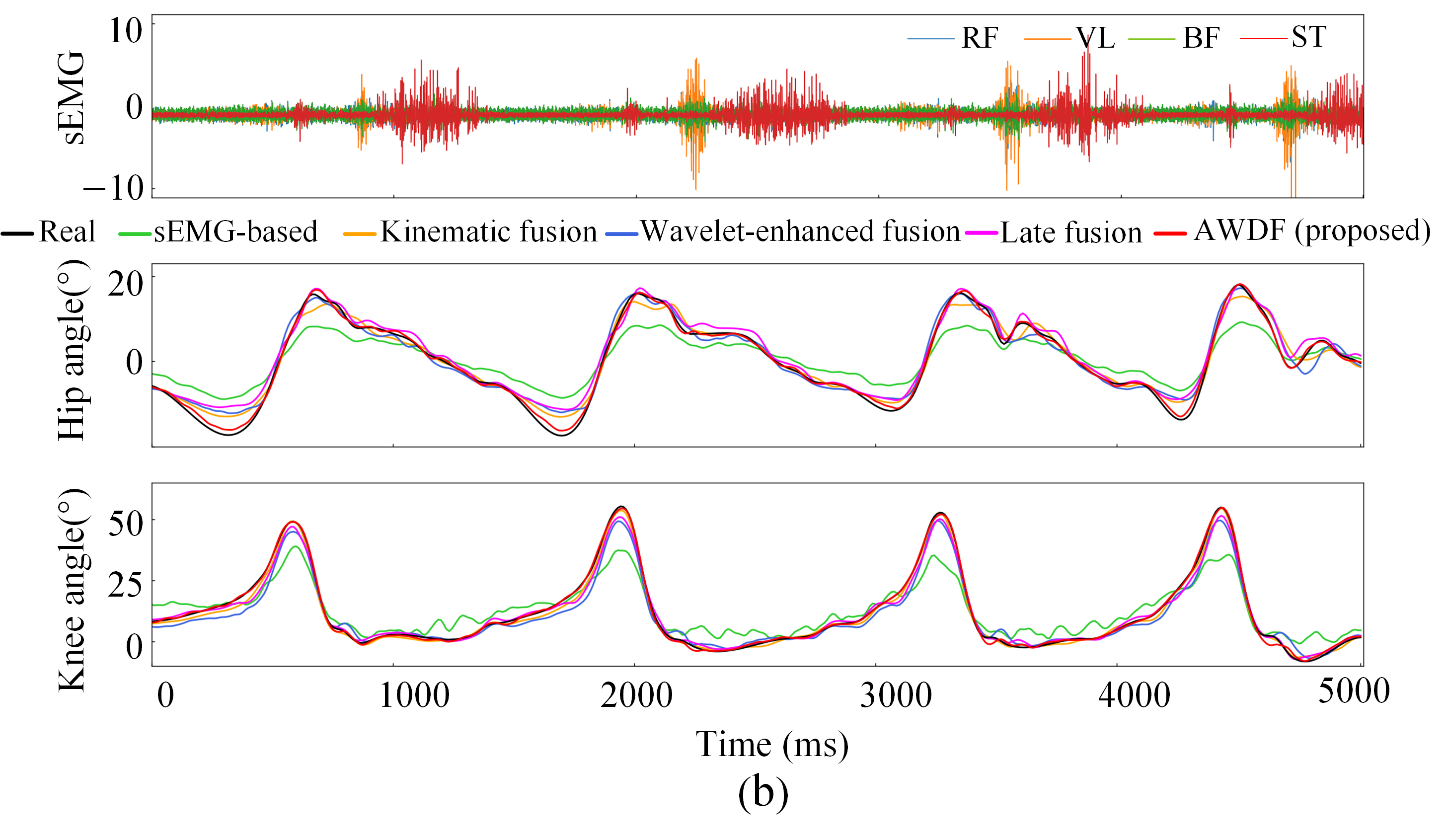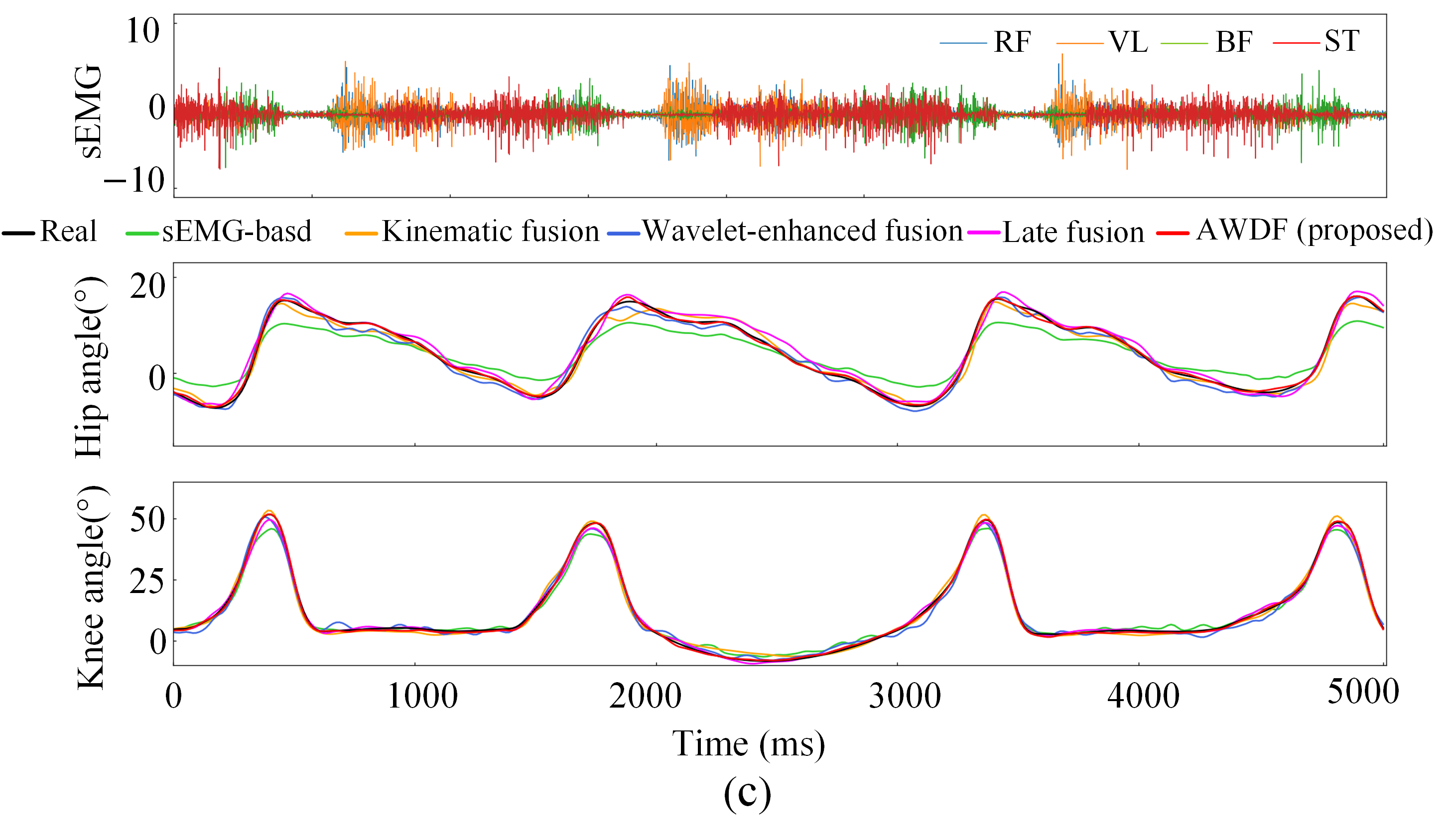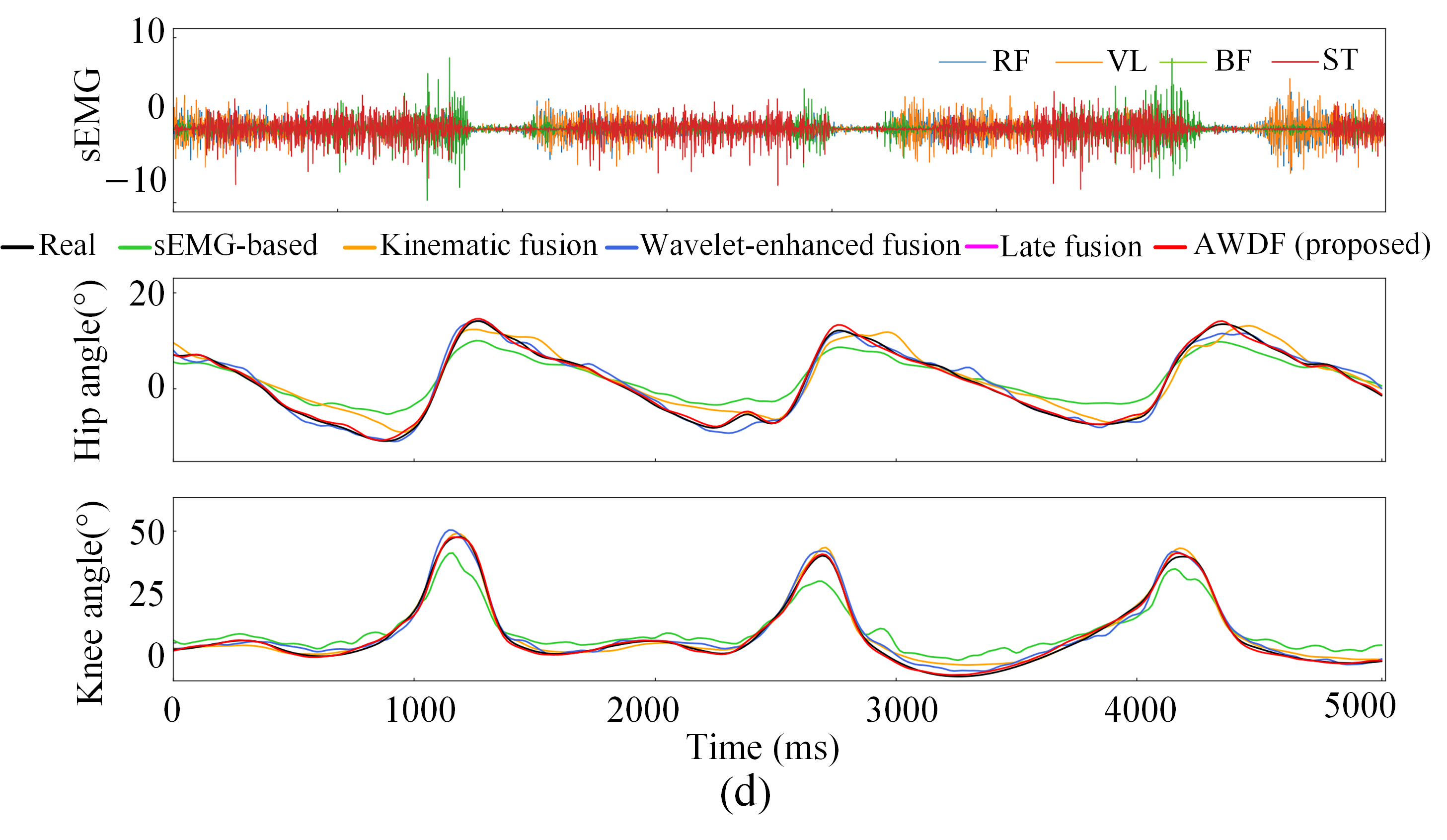1. Introduction
Bodyweight-supported training (BWST) is employed in neurological rehabilitation to facilitate gait training through partial weight unloading. This therapeutic approach reduces biomechanical loads for non-ambulatory patients while maintaining postural stability, thereby enabling safe completion of locomotor protocols and fall prevention during therapeutic sessions [
1]. Clinical evidence confirms that exoskeleton-assisted BWST enhances locomotor recovery through adaptive BWSL modulation during repetitive gait training, particularly benefiting patients with stroke-induced or age-related mobility impairments [
2,
3].
Building on the therapeutic benefits of BWST, accurate motion intention recognition constitutes the foundation of active compliance control in lower-limb exoskeletons [
4,
5]. Human motion intention recognition encompasses discrete movement classification and continuous motion intention prediction. Current research prioritizes continuous motion intention prediction over discrete movement classification, particularly in exoskeleton control applications. However, current methodologies conflate estimation with prediction by employing synchronous joint angle estimation during motion execution, relying on biomechanical signals as post hoc data labels [
6,
7,
8]; current research on lower-limb joint angle prediction remains limited. Importantly, continuous predictive algorithms outperform estimation-based approaches in compensating system latency and signal transmission delay inherent in human–robot interaction systems.
Surface electromyography (sEMG) captures the bioelectric potentials reflecting neuromuscular activation patterns associated with movement intention. In our previous studies, we have conducted research on sEMG-based gait pattern recognition and knee angle prediction [
9,
10]. Other researchers, such as Foroutannia et al. [
11], developed a deep learning framework that decodes sEMG signals for hip joint position prediction and exoskeleton assistive torque calculation. Subsequent studies by Lu et al. [
12] and Han et al. [
13] further advanced the sEMG-based prediction using Conv-BiLSTM and ensemble XGBoost regression models, respectively. However, current research predominantly focuses on natural locomotion patterns (walking, running, stair ascent/descent), and prediction algorithms specifically adapted to BWST environments remain unexplored. The unique biomechanical context of BWST modulates lower-limb muscle strength, neuromuscular activation levels, coordination patterns, and movement characteristics. Liu et al. [
14] demonstrated that different bodyweight support levels (BWSL), 0–40%, can lead to significant changes in the root mean square and other sEMG features of muscles. Consistent with these findings, Kristiansen et al. [
15] and Bu et al. [
16] quantified BWSL-induced changes in muscle activation levels and fiber dynamics during gait training. Das et al. [
17] used Higuchi’s fractal dimension analysis to estimate fractal dimension of the sEMG signal, and implemented Detrended Fluctuation Analysis to examine the change in sEMG signals with varying weights. Critically, these neuromuscular adaptations may compromise the reliability of sEMG-based motion intention recognition. Nevertheless, the influence of BWSL variations on joint angle prediction accuracy has not been systematically investigated.
The selection of sEMG features under varying BWSLs critically influences motion intention prediction accuracy. Traditional methods primarily employ three categories of handcrafted features: time-domain, frequency-domain, and time-frequency domain. Lu et al. [
12] systematically compared these features in regression models, while Song et al. [
18] utilized RMS time features for joint angle prediction. Although these handcrafted features achieve moderate performance in controlled environments, their reliance on linear assumptions fails to address the non-stationary nature of sEMG signals and muscle synergy patterns under BWSL-induced neuromuscular adaptations. In contrast, deep learning approaches, such as CNN-based automatic feature extraction and unified spatiotemporal-frequency frameworks like Deep-STF [
19,
20], exhibit enhanced capability in modeling complex sEMG patterns. Despite the demonstrated superiority of model-based learning approaches for feature extraction in automatically capturing sEMG patterns, their performance becomes inherently constrained under varying BWSLs conditions. Specifically, sEMG signals are influenced by BWSL variations with changing muscle activation patterns. To address these challenges, adaptive signal processing techniques capable of capturing both temporal and spectral dynamics are imperative. This necessitates a paradigm shift toward methods that inherently accommodate the time-frequency variability of sEMG under dynamic unloading conditions.
Wavelet transform (WT) demonstrates unique advantages in addressing sEMG signal degradation through multi-resolution time-frequency analysis. Empirical studies validate the effectiveness of discrete wavelet transform (DWT) coefficients as discriminative features. Xi et al. [
7] successfully estimated joint angles using wavelet coefficients, while Duan et al. [
21] enhanced pattern recognition by selecting maximum absolute DWT coefficients. The robustness of this approach is further evidenced by Zafar et al. [
22], who applied the DWT technique to extract features from the filtered sEMG signal for hand gesture recognition. These successes stem from WT’s ability to decompose non-stationary signals while preserving neuromuscular activation patterns through threshold-optimized coefficient selection. However, current implementations face critical limitations in BWST scenarios: fixed decomposition levels and static thresholds fail to adapt to BWSL-dependent SNR variations. Therefore, DWT coefficient features can be optimized with adaptive thresholds, effectively preserving neuromuscular activation features while mitigating BWSL-induced activation changes.
To address the challenges of predicting joint angles under dynamic BWSL conditions, this study proposes a novel adaptive wavelet-denoising fusion (AWDF) model for continuous joint angle prediction during BWST. To the best of our knowledge, this work represents the first systematic exploration of adaptive sEMG denoising and joint kinematics prediction tailored for BWST.
This applied contribution is designed to tackle the core hypothesis that (1) variations in BWSLs induce significant changes in the characteristics of muscle activation, which consequently affect joint angle prediction accuracy; (2) an optimal prediction time horizon exists that effectively balances the compensation for system latency against the degradation in prediction fidelity, and this horizon is feasible for real-time exoskeleton control; and (3) the proposed adaptive multi-feature fusion model will outperform baseline models in predicting hip and knee joint angles across all BWSLs.
Moving beyond these applied innovations, this work also ventures into a scientific exploration of the nonlinear dynamic properties of neuromuscular systems under BWST. We hypothesize that BWSL alterations not only change muscle activation intensity, but also fundamentally modulate the complexity and regularity of motor control strategies. To test this, we employ a multidimensional feature analysis—Higuchi’s fractal dimension [
23,
24], sample entropy [
25], and root mean square [
26]—to uncover the nuanced influences of BWSL on lower-limb muscle activities from complementary perspectives.
The rest of this paper is organized as follows:
Section 2 introduces the architecture of the proposed AWDF prediction model and details the methodology for the feature analysis of sEMG signals.
Section 3 describes the experimental platform and the detailed protocol designed for data collection.
Section 4 presents the results, analyzing the impact of both BWSL and prediction time on model performance, as well as the trends observed in the sEMG feature analysis. Finally, the findings are thoroughly discussed in
Section 5, and
Section 6 outlines our conclusions.
3. Platform and Experiment
3.1. Human-Tracking Bodyweight Support System (BWSS)
Exoskeleton-integrated BWST has emerged as a neurorehabilitation breakthrough. Current clinical implementations predominantly utilize two architectural paradigms [
2], as illustrated in
Figure 5a: overhead rail-mounted systems with spatial constraints; and fixed treadmill-based configurations with limited gait variability.
Our research team has developed an overground exoskeleton-integrated BWSS, as shown in
Figure 5b, which comprises two synergistic subsystems: human-tracking BWSS (mobile platform with real-time position synchronization) and lower-limb exoskeleton (powered joints for gait assistance). Exoskeleton has four active joints, hip/knee bilaterally, driven by brushless DC motors with harmonic drives to amplify torque output. All joints operate exclusively in the sagittal plane to provide physiological gait assistance during weight-supported training. The exoskeleton features length-adjustable thigh and shank segments to accommodate users across 155–185 cm height ranges. In contrast, the proposed robotic system enables a more natural overground walking pattern, thereby offering greater adaptability during rehabilitation training. The real-time BWSL adjustment through PID-controlled servo mechanisms, achieving across 0–40% BWSL via strain gauge feedback and lead screw actuation. The system’s mobile platform maintains human-tracking accuracy within 10 cm positional tolerance during dynamic locomotion while enabling natural walking pattern rehabilitation synchronization.
Figure 6 details the developed human-tracking BWSS. The robotic system detects slider displacement along linear guide rails using laser displacement sensors, enabling precise human motion perception. Synchronized motion tracking is achieved through servo motors, while tension sensors continuously monitor bodyweight support force. A screw motor dynamically regulates this force via closed-loop control. The system architecture comprises four integrated subsystems for power delivery, multimodal sensing, real-time control, and electromechanical actuation.
3.2. Signal Acquisition System
In this study, sEMG signals and IMU data were synchronously acquired through the integrated system illustrated in
Figure 7.
sEMG signals from the right lower-limb were captured using a four-channel wired acquisition system (Sichiray Co., Ltd., Kunshan, China) equipped with pre-gelled Ag/AgCl electrodes. The system operated at a sampling rate of 500 Hz, with a signal amplification gain of 2000 and a 12-bit analog-to-digital converter resolution. The electrodes were placed on the muscle bellies of four critical locomotor muscles after standard skin preparation, cleaning with alcohol swabs, to ensure inter-electrode impedance below 3 kΩ.
Joint kinematics were captured using three wireless IMU sensors (WT901WIFI, Wit Motion Co., Ltd., Shenzhen, China). Each IMU, streaming data at 100 Hz, integrates a triaxial accelerometer with a range of ±16 g, a triaxial gyroscope with a range of ±2000°/s, and a triaxial magnetometer. The sensors were calibrated prior to data collection using the manufacturer’s proprietary procedure to minimize offset and scale factor errors.
The raw data were streamed at 100 Hz via a WIFI connection to a host router and then forwarded to an embedded industrial computer. The orientation data output by the sensors were used to compute hip and knee joint angles. A multi-unit parallelization strategy was implemented using serial communication cables (23,400 bps baud rate) for the sEMG system, achieving stable 500 Hz real-time sampling via an Arduino UNO microcontroller-based signal conditioning hardware. Temporal synchronization across all sensor nodes (sEMG and IMU) was ensured through a hardware-triggered timestamp alignment protocol implemented on the industrial computer. A custom Python 3.12 script sent a simultaneous start command and generated a shared trigger pulse; temporal synchronization across all sensor nodes was ensured through hardware triggered timestamp alignment implemented on the industrial computer, maintaining inter-device clock deviation below 1 ms during trials.
The human upper body, thigh, and shank were simplified into a three-link mechanism, as shown in
Figure 7a.
is the rotation matrix of the upper body relative to the thigh.
is the rotation matrix of the thigh relative to the shank.
are the rotation matrixes of three links relative to the ground, and can be calculated using an algorithm of the Euler-angle-to-rotation matrix based on IMU dates. Consequently, the hip and knee joint angles were derived using an algorithm for converting rotation matrices to Euler angles, as defined in Equations (27) and (28):
3.3. Experimental Protocol
Ten subjects (5 males and 5 females; age range: 23–27 years; mass range: 60–75 kg; height range: 158–182 cm), who had no history of lower-limb disorders, volunteered to participate in the experiment. All experiments were approved by the Ethical Committee of Anhui University of Science and Technology, and all participants provided written informed consent before the experiment.
As shown in
Figure 7, the subject wore the multisource signal acquisition system and walked on the ground with a natural gait pattern while the developed bodyweight support system followed them automatically. The BWSLs were set to 0%, 10%, 20%, 30%, and 40% in this study. The maximum support level 40% was based on the clinic study about bodyweight supported training on gait rehabilitation [
2]. Four muscles from one leg were selected to incorporate most functional muscles relative to normal walking, including rectus femoris (RF), vastus lateralis muscle (VL), biceps femoris (BF), semitendinosus (ST). Subjects were first required to become familiar with the experimental equipment, and walked along a straight for 8 m walkway on a flat ground environment. Each participant completed two consecutive trials under each BWSL, yielding 100 datasets (10 participants × 5 BWSLs × 2 trials). To mitigate muscle fatigue and ensure data reliability, a 5 min rest interval was enforced after each BWSL condition.
The sEMG signal precedes muscular contraction by about 50–100 ms and occurs approximately 30–150 ms prior to the actual movement [
4]. The current sEMG features represent the movement of the future moment, and we use prediction time to compensate the electromechanical delay during model training. To assess the influence of prediction time and define its optimal range, six intervals were selected (30 ms, 60 ms, 90 ms, 120 ms, and 150 ms), aligning with physiological electromechanical delay ranges and data synchronization requirements.
To evaluate the predictive performance of the proposed model, a Leave-One-Out Cross-Validation (LOOCV) protocol was implemented. In each iteration, one participant’s dataset served as the test set, while data from the remaining four participants were used for training. The model was trained using the Adam optimizer with an initial learning rate of 0.0001, a batch size of 128, and 2000 epochs. Computational implementation utilized PyTorch 2.1.0 on a system equipped with an Intel i5-12700K CPU (Intel Corporation, Santa Clara, CA, USA), 64GB DDR5 RAM (Samsung Corporation, Suwon, Republic of Korea), and an NVIDIA GeForce RTX 4080 GPU (NVIDIA Corporation, Santa Clara, CA, USA). Training convergence was monitored using real-time visualization of loss landscapes and gradient distributions. Four ablation baseline models were systematically constructed to isolate feature contributions and evaluate the effectiveness of the proposed AWDF model. A one-way ANOVA was used to determine whether there was a statistically significant difference between the models in the ablation study.
(1) sEMG-based model: Integrated LSTM2-based sEMG features with BWSL parameters, serving as the foundational architecture for neuromuscular activation pattern analysis.
(2) Kinematic fusion model: Augmented the EMG-baseline model by incorporating real-time joint angle feedback through biomechanical sensor fusion.
(3) Wavelet-enhanced fusion model: Introduced threshold-free wavelet denoising coefficients to the kinematic fusion framework. This configuration validated the AWDF’s core innovation in adaptive bodyweight support influence while preserving transient neuromuscular activation characteristics.
(4) Late fusion model: This method first generated independent joint angle predictions from three separate models, each trained exclusively on one feature subset: ADTLM-based features, LSTM-based features, or joint kinematic features. The final prediction was then obtained by a learnable weighted fusion of these three model outputs.
In summary, the experimental protocol systematically analyzed three critical factors across five prediction time horizons (30–150 ms at 30 ms increments), five BWSLs (0–40% in 10% increments), and five prediction models (sEMG-based model, kinematic fusion model, wavelet-enhanced fusion model, late fusion model), and five prediction models (sEMG-based model, kinematic fusion model, wavelet-enhanced fusion model, late fusion model, and the proposed AWDF model)..
5. Discussion
5.1. Performance of Joint Angle Prediction with Various BWSLs
This study investigates joint angle prediction performance during BWST and demonstrates an enhancement in joint angle prediction accuracy with increasing BWSLs, a trend consistently observed across all evaluated models (
Figure 11). While the existing literature extensively documents BWST applications, to our knowledge, this study represents the first systematic investigation of joint angle prediction under BWST experimental conditions.
As detailed in
Section 4.1, BWST significantly alters gait patterns and sEMG characteristics, and increasing BWSL prolongs gait cycle duration and modifies RMS values of muscle activations. Previous studies have established BWSL-dependent biomechanical changes. Kristiansen et al. [
15] demonstrated differential activation patterns in lower-limb muscles during BWSL escalation, with most muscles exhibited reduced activation intensities, while others like the BF displayed non-monotonic variations, which aligns with our results shown in
Figure 8b. Similarly, Liu et al. [
14] reported BWSL-dependent changes in lower-limb kinematics and muscular properties, notably, a BWSL-correlated reduction in step frequency, which aligns with our findings demonstrated in
Figure 8a. While previous studies collectively confirm BWST’s biomechanical impacts, the key findings of our study reveal a counterintuitive relationship between BWSL modulation and prediction accuracy: despite progressive reductions in bodyweight, from 0% to 40%, joint angle prediction performance exhibited significant improvements.
From a rehabilitation perspective, this finding has significant implications. The enhanced prediction accuracy under higher BWSL conditions suggests that adaptive exoskeleton control may be most effective during early rehabilitation phases when bodyweight support is maximized. This aligns perfectly with clinical rehabilitation paradigms, where support is gradually reduced as patient capability improves. Our results provide a computational foundation for developing BWSL-aware control strategies that can dynamically adjust prediction models based on support levels.
The AWDF model’s ability to maintain high prediction accuracy across varying BWSL conditions demonstrates its robustness in handling these fundamental changes in neuromuscular dynamics. By adaptively filtering sEMG features and integrating multimodal data, the model effectively captures the essential neuromuscular information relevant for prediction, regardless of the support level. This adaptability underscores the importance of developing BWSL-aware algorithms for robust human–robot interaction in adaptive rehabilitation scenarios.
5.2. Analysis of Joint Angle Prediction in Advance
The extension of prediction time can mitigate electromechanical system delay; our study reveals a progressive degradation in prediction accuracy with longer time intervals. As shown in
Table 3, Yi et al. [
38] quantified this tradeoff, demonstrating performance degradation in LSTM models as prediction time increased, with optimal intervals identified at 54–81 ms. Fu et al. [
20] investigated the impact of varying prediction horizons on joint angle prediction accuracy using Deep-STF model, suggesting an optimal prediction horizon of 250 ms for continuous ambulatory scenarios. Song et al. [
18] systematically evaluated the impact of prediction horizons on LSTM-based joint angle prediction accuracy, reporting a progressive degradation in prediction fidelity with extended prediction intervals, achieving optimal performance at 50 ms.
The present study identified an optimal prediction time of approximately 90 ms, diverging from previous studies, notably, a difference of 250 ms. This discrepancy arises because discrete locomotion modes prediction using plantar pressure sensors necessitated extended prediction horizons, inherently requiring a longer prediction horizon compared to IMU-driven continuous kinematic tracking systems. Furthermore, the various prediction model may lead to different optimal prediction horizons. These results emphasize that prediction horizon selection represents a tradeoff between electromechanical delay compensation (requiring longer horizons) and motion intention prediction performance (favored by shorter horizons). The determination of optimal prediction time is influenced by sensor system heterogeneity, task-specific requirements, and model architectural variations. However, we choose the pronounced inflection points that emerged at 90 ms, where RMSE, CC, and Adjusted R2 start to change significantly. The inflection point is not the only standard to decide optimal prediction time; it depends on the delay of the deployed exoskeleton system. In this study, the inference time of executing the proposed AWDF algorithm is about 12 ms, achieved using a CPU i5-12700K and GPU GeForce RTX 4080. Therefore, the prediction time is large enough to cover the execution of the prediction algorithm and still leaves enough room for compensating the mechanical transmission delay.
5.3. Effectiveness of the Proposed AWDF Prediction Model
This study proposes an AWDF model to address joint angle prediction under varying BWSLs. The AWDF model integrates adaptive threshold denoising for sEMG wavelet coefficients, along with multimodal fusion of sEMG, joint angle kinematics, and BWSL features. Comparative experiments with four baseline models demonstrate AWDF’s superior accuracy and effectiveness. As shown in
Figure 9 and
Figure 11, results indicate that the sEMG-based model (solely relying on LSTM features) exhibited the lowest prediction accuracy, highlighting the limitations of isolated sEMG features for BWST applications. Incorporating joint angle kinematic features significantly improved prediction performance, validating the positive effects of feature fusion. To further verify the efficacy of the ADTLM in sEMG feature learning, the wavelet-enhanced fusion model was compared against the AWDF. Experimental results confirm the superiority of the ADTLM in automatically selecting threshold-filtered wavelet coefficients with higher relevance to prediction tasks.
As shown in
Table 1, the superior performance of the proposed AWDF model over the late fusion variants underscores a key advantage of feature-level fusion for this specific continuous regression task. While late fusion strategies like graph-regularized combination are powerful for classification, their comparative shortcomings here can be attributed to a fundamental limitation: the loss of rich, cross-modal information during the intermediate decision-making stage [
34,
35]. In contrast, our AWDF model’s early fusion strategy integrates these heterogeneous data streams before they are transformed into predictions. This allows for the model to learn a unified, discriminative feature representation where interactions between a specific sEMG pattern, a particular joint angle, and a given BWSL can be directly discovered and exploited by the subsequent nonlinear mapping network. Comprehensive comparisons demonstrate that the AWDF model adaptively accommodates BWSL variations during BWST application, thereby improving joint angle prediction accuracy.
Although joint angle estimation and joint angle prediction represent distinct conceptual frameworks, their divergence primarily manifests in data labeling protocols rather than fundamentally impacting regression models’ inherent performance. To broaden comparative analyses, this study disregards these distinctions; relevant studies are illustrated in
Table 4. Adjusted R
2 and R
2 values are consolidated into a single column, with RMSE metrics rounded to two decimal places. Existing studies employ diverse regression models for joint angle prediction (estimation); however, the proposed AWDF model does not achieve optimal performance across all benchmarks. BWST conditions and prediction time horizons are identified as critical factors influencing model efficacy. Nevertheless, the AWDF model prediction satisfies the fundamental accuracy requirements for lower-limb exoskeleton control applications.
The ablation studies further substantiate the AWDF model’s design. As shown in
Table 2, the superiority of the Db8 wavelet over Haar confirms that a wavelet matched to sEMG’s non-stationary nature—with better frequency localization—yields more physiologically relevant features. Conversely, the Haar wavelet’s discontinuous nature proved to be less capable of preserving these subtle patterns. Similarly, the optimal performance of the two-layer LSTM suggests that this depth sufficiently captures the temporal dynamics of muscle synergies without over-parameterization. Thus, the model’s efficacy is rooted in these principled, validated architectural choices.
5.4. Fractal Nature of Muscle Control Under BWST: Insights from HFD Analysis
While RMS and SampEn remain valuable indicators of muscle activation intensity and signal irregularity, respectively, their responses to BWSL variations in our study were heterogeneous and less consistent. In contrast, HFD demonstrated a strong, systematic negative correlation with increasing BWSL across all conditions, underscoring its superior utility as an indicator of neuromuscular adaptation under dynamic unloading. The unique capability of HFD makes it a promising indicator for decoding neuromuscular adaptations under dynamic unloading.
The theoretical supremacy of HFD stems from its ability to quantify the fractal nature—the self-similarity and complexity—of the underlying motor control strategy. The observed decrease in HFD signifies a fundamental simplification and regularization of the neural drive to muscles as BWSL increases. This suggests that, under reduced biomechanical load, the central nervous system adopts a more stereotyped and less adaptive motor unit recruitment pattern [
26,
43]. Thus, the reduction in HFD provides a profound explanation for the BWSL-induced changes: it reveals a shift in the fractal characteristics of the control signal itself, marking a transition towards a simpler neuromuscular control regime.
Furthermore, the exceptional performance of our AWDF model can be reinterpreted through this lens of fractal analysis. The model’s core innovation lies in its adaptive wavelet thresholding, which is inherently designed to preserve and leverage the fractal properties of the sEMG signal. By dynamically tuning its denoising parameters based on BWSL, the AWDF model effectively compensates for the loss of signal complexity (HFD decrease) quantified in our analysis. This intrinsic alignment between the model’s architecture and the fractal nature of the signal provides a deeper theoretical foundation for its superior prediction accuracy and cross-condition robustness.
5.5. Limitations and Future Directions
This study introduced a novel AWDF model for joint angle prediction during BWST, yet several limitations must be noted, pointing to clear avenues for future work.
First, while the inclusion of ten healthy young adults enhanced generalizability, the absence of clinical populations and older age groups remains a constraint. Future work will therefore prioritize clinical validation in patient cohorts to evaluate the model’s utility in real-world rehabilitation settings.
Second, the scope of this work was limited to overground walking in the sagittal plane. To assess the model’s full versatility, future studies will extend the framework to more complex tasks such as stair climbing, sit-to-stand transitions, and balance control. Additionally, the long-term repeatability of predictions and robustness to muscle fatigue during prolonged use warrants further investigation.
Third, although ablation studies justified key model choices and desktop tests confirmed computational feasibility, the model has not been deployed on embedded hardware. The critical next step is to port and validate the AWDF model on a portable exoskeleton system, ensuring real-time performance in a closed-loop control environment.
By addressing these aspects, the AWDF model can evolve from a proof-of-concept into a robust, clinically viable technology for adaptive neurorehabilitation.
6. Conclusions
This study presents a systematic investigation of continuous lower-limb joint angle prediction under dynamic BWST conditions. To address the unique challenges posed by varying BWSLs, an AWDF model was developed, integrating multimodal features from sEMG, IMU kinematics, and BWSL parameters. The core findings and contributions of this work are fourfold:
First, this study was the first to report and quantify a previously unreported phenomenon: joint angle prediction accuracy improves with increasing BWSL. This counterintuitive finding was analyzed through multidimensional perspectives, revealing that reduced gravitational load leads to a simplification of neuromuscular control, which in turn yields more predictable sEMG patterns for data-driven models.
Second, the proposed AWDF model demonstrated superior performance and robust cross-condition adaptability against several baseline models. The average RMSE, CC, and Adjusted R2 for hip and knee angle prediction are 1.468°–2.626°, 0.983–0.973, and 0.992–0.986, respectively. Its novel adaptive wavelet thresholding module effectively preserves discriminative neuromuscular features while mitigating noise induced by BWSL variations, establishing a new state-of-the-art framework for BWST applications.
Third, the influence of prediction time was thoroughly explored, identifying an optimal prediction horizon of 90 ms that effectively balances the compensation for system latency against the degradation in prediction accuracy. This finding provides a crucial design parameter for real-time exoskeleton control systems.
Fourth, using a multiscale feature analysis, we provide a novel interpretation of the fractal nature of neuromuscular control under BWST. The systematic decrease in HFD emerged as the most consistent biomarker, offering profound insights into how the central nervous system simplifies control strategies under reduced gravitational loading.
